Horeca Furniture Market Research, 2032
The global HoReCa furniture market was valued at $171,322.6 million in 2022, and is projected to reach $263,940.0 million by 2032, registering a CAGR of 4.6% from 2023 to 2032.
HoReCa furniture refers the furniture tailored for use in the hospitality industry, especially in hotels, restaurants, and cafes. It encompasses a diverse range of furniture items that are custom-made to meet the unique requirements and preferences of these establishments. HoReCa furniture is constructed with various essential factors in consideration, such as durability, functionality, aesthetic appeal, and comfort. These furniture pieces are designed to withstand heavy usage and frequent cleaning, as they are intended for commercial environments where people may utilize them daily. Examples of HoReCa furniture include restaurant chairs, tables, bar stools, lounge seating, hotel room furniture, outdoor furniture for cafes or patios, banquet chairs, and other specialized pieces.
The Horeca Furniture industry has experienced significant growth driven by the expansion of the beverages industry all across the globe. The increase in popularity of quick food services and the rise in disposable income of individuals have generated a need for furniture in various establishments such as hotels, restaurants, cafes, and catering services. The future outlook indicates a growing demand for suitable furniture, driven by the economic development in various countries. Establishments in the HoReCa market (Hotels, Restaurants, and Cafe) heavily rely on a diverse range of furniture, including tables, chairs, bar stools, booths, and outdoor seating, to enhance the overall ambiance and atmosphere for their customers and visitors. To gain a competitive edge in this industry, players are striving to distinguish themselves by offering unique dining experiences, achieved through the incorporation of high-quality, well-designed furniture that complements the establishment's theme and ambiance. Moreover, the expansion of the food and beverages industry serves as a driving force for the significant growth of the HoReCa furniture market, as establishments aim to enhance their offerings and provide memorable experiences for their customers. Thus, the demand for HoReCa furniture has gained momentum and is expected to experience significant growth in the coming years.
The scarcity of skilled labor in the HoReCa furniture market poses significant challenges across various aspects of the business. It adversely affects production capacity, which leads to delays in fulfilling orders and missed opportunities for growth. Moreover, insufficient skilled workers compromise quality control, which potentially damage the reputation of companies operating in the market and have an impact on customer satisfaction. The lack of skilled labor limits the ability of the industry to innovate and design furniture that meets evolving consumer preferences. This restriction hampers the industry's capacity to adapt to changing market trends and potentially leads to missed business opportunities. In addition, the high demand for limited skilled workers can drive up labor cost and may impact profit margins for companies in the market. The increased expenses associated with securing skilled labor further add to the financial challenges faced by businesses. Furthermore, the industry faces a considerable challenge in integrating and maximizing the potential of advanced manufacturing technologies due to the scarcity of skilled labor. The lack of a proficient workforce capable of effectively operating and leveraging these technologies may hinder the industry's ability to fully leverage their benefits in terms of efficiency, productivity, and market competitiveness.
The surge in prevalence of global events and exhibitions presents highly profitable opportunities for the furniture manufacturers who produces furniture used in hotels, restaurants, and cafes, which leads to increase in Horeca Furniture Market Size. These events generate a significant surge in demand for accommodations and dining, which allows HoReCa establishments to take advantage of the increased number of visitors. It is essential to cater to the diverse preferences of attendees by providing a wide range of seating styles that can accommodate various needs, thereby enhancing overall customer satisfaction. In addition, participation in these events opens doors to valuable networking and partnership opportunities with event organizers, exhibitors, and attendees. This fosters potential business growth and expands market exposure. Moreover, major market players differentiate themselves by creating immersive experiences that align with the themes of the events. They achieve this by the integration of elements of the event into their furniture designs and offering customization and flexibility. These factors become key differentiators in the industry as it helps to stand out from other various players operating in the market. Furthermore, investment in outdoor seating options and incorporation of eco-friendly designs align with sustainability trends and serve as an added attraction for event attendees. This concerns addressed promptly has high potentiol to increase the Horeca Furniture Market Share during the forecasted period. This strategic approach further enhances the appeal of HoReCa establishments and increases their chances of retaining customers during these events.
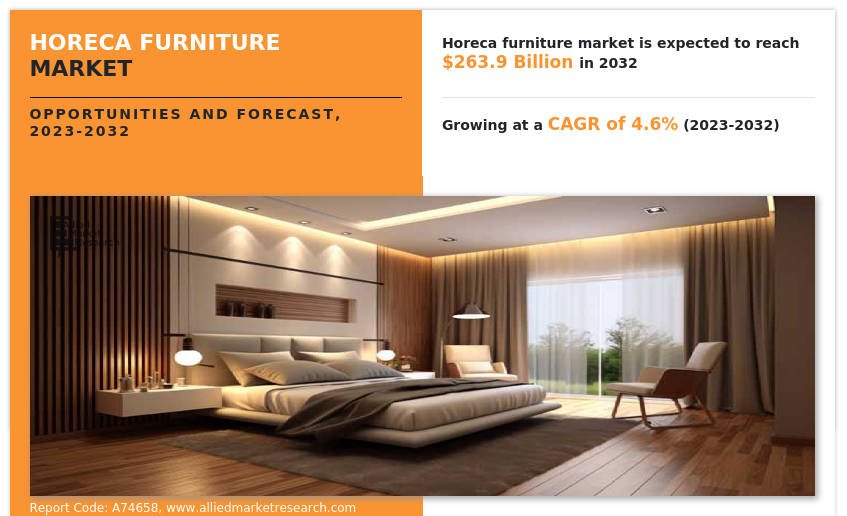
SEGMENTAL OVERVIEW
The HoReCa furniture market is segmented on the basis of product type, material, category, and region. On the basis of product type, the market is segregated into beds, tables/desks, chairs/stools, sofa/couches, and others. By material, it is divided into wood, metal, plastic, and others. By category, the market is bifurcated into indoor and outdoor. Region wise, it is analyzed across North America (the U.S., Canada, and Mexico), Europe (the UK, Germany, France, Italy, and rest of Europe), Asia-Pacific (China, Japan, India, Australia, South Korea, Thailand, and rest of Asia-Pacific), and LAMEA (Brazil, Argentina, South Africa, Middle East, Saudi Arabia, and rest of LAMEA).
BY PRODUCT TYPE
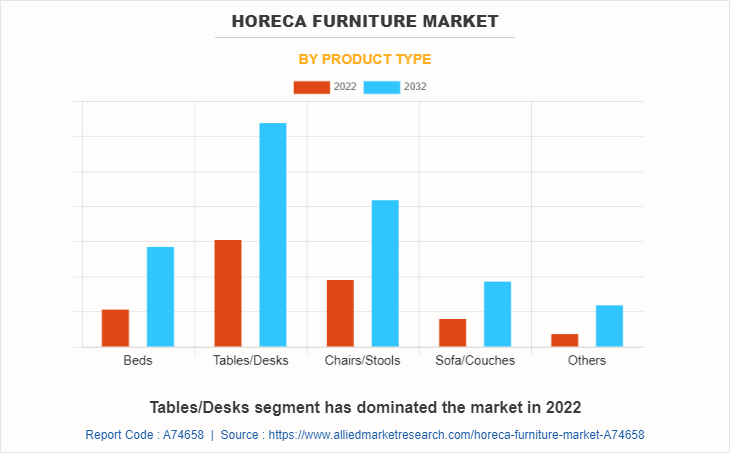
On the basis of product type, the tables/desks segment dominated the market, garnering a market share of 29.3% in 2022. One of the main factors that drives the demand for tables and desks in the industry is the need to accommodate a large volume of customers who visit these establishments for dining or work purposes. Tables and desks serve as essential elements for facilitation of various activities and providing suitable workspaces. Hence, integrating chic and well-crafted tables and desks can enable establishments to cultivate an inviting ambiance that elevates the overall dining experience. The escalating demand for informal dining experiences at more budget-friendly price ranges has fueled the growth of casual dining. This shift is driven by changes in consumer lifestyles, the increasing popularity of fusion cuisine, and the emergence of fast casual restaurants and cafes. Moreover, outdoor dining has become immensely popular as consumers seek pleasant weather and a distinctive atmosphere. The recent upsurge in al fresco dining trends can be attributed to the rise in locally sourced dining choices, favorable weather conditions, and the pervasive influence of social media. As a direct consequence, there is a projected substantial increase in demand for restaurant and cafe tables and desks throughout the forecast period.
BY MATERIAL
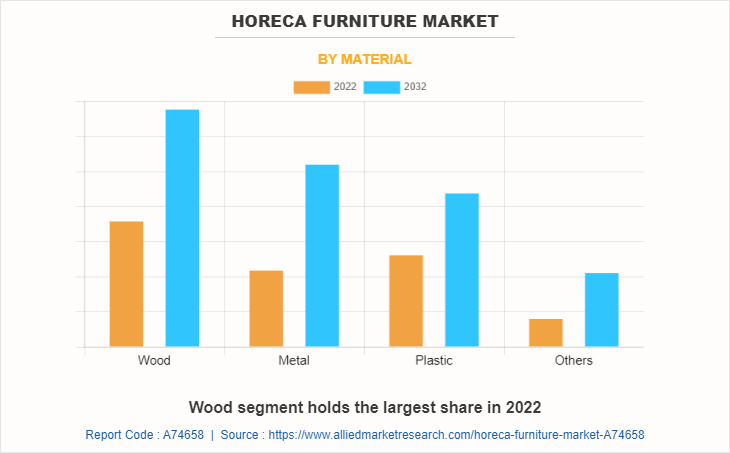
On the basis of material, the wood segment dominated the market, garnering a market share of 32.5% in 2022. Wood furniture holds significant appeal for hotels and restaurants within the HoReCa furniture industry, as it offers a range of advantages starting from its durability to longevity, which makes them a highly sought after product in the furniture category. One key benefit is its exceptional durability, which allows it to withstand heavy use and frequent cleaning without experiencing issues such as chipping, cracking, or warping. This durability ensures that wood furniture can maintain its quality and appearance over time, makes it a reliable choice for establishments with high customer turnover. The versatility of wood furniture is another advantage, as it comes in a wide variety of styles and finishes in different designs, which allows customization as per the demand of the business. This enables hotels, restaurants, and cafes to effortlessly match their existing decor and utilize wood furniture in various settings. Whether aiming for a classic, rustic, or contemporary ambiance, wood furniture can seamlessly complement the desired atmosphere. Moreover, the natural beauty of wood, with its distinct grain patterns and textures, adds warmth and depth to any space. This aesthetic quality creates a welcoming and inviting atmosphere for enhances their overall experience. In addition to its durability and aesthetic qualities, wood furniture aligns with the growing emphasis on environmental responsibility in the industry. Wood is a renewable resource, and many wood furniture manufacturers prioritize sustainable forestry practices during the whole process. This commitment to sustainability resonates with hotels, restaurants, and cafes that prioritize eco-friendly initiatives with the rise in trend of green practices. Thus, the Horeca furniture market demand is expected to rise following the trend, which may lead to Horeca furniture market growth during the Horeca furniture market forecast period.
BY CATEGORY
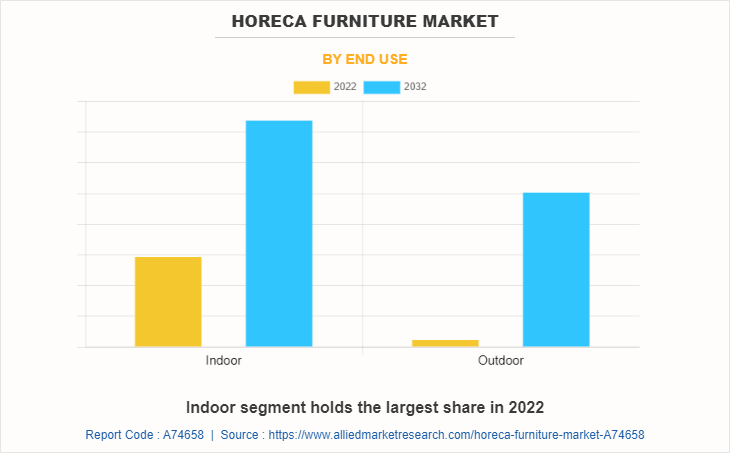
By category, the indoor segment dominated the market, garnering a market share of 57.9% in 2022. Indoor dining areas offer a controlled climate that ensures guest comfort, regardless of external weather conditions. This controlled environment provides an exclusive dining experience for guests and visitors. Moreover, indoor dining areas are often equipped with superior sound insulation, which reduces noise pollution and creates a serene atmosphere. The availability of indoor dining enables year-round operation and o provides consistent revenue streams for establishments. The integration of technology into indoor spaces, convenience and engagement gets enhanced, with features such as charging stations and interactive menus. In addition, the design of indoor furniture prioritizes accessibility, which makes it easier to accommodate guests with disabilities without putting much effort. Thus, the indoor furniture segment is expected to thrive and expand in the anticipated period.
BY REGION
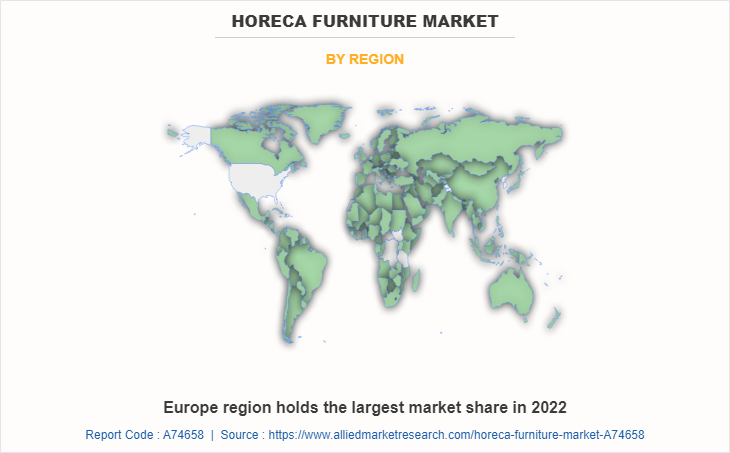
On the basis of region, Europe dominated the market, garnering a market share of 33.2% in 2022. In the European HoReCa furniture market, emphasis is placed on the importance of design. Businesses within this industry make investments in furniture that embodies elegance and attractiveness, with the goal of creating a positive dining experience for their customers. Modular furniture has witnessed a surge in popularity due to its adaptability, allowing it to be easily reconfigured to meet the evolving needs of businesses. Safety and security are key considerations for HoReCa establishments, which necessitates the use of furniture constructed with fire-resistant materials and they incorporate features such as anti-slip surfaces and tamper-proof screws, which ensures the well-being of their customers. The vibrant outdoor dining culture in Europe generates a demand for outdoor furniture that strikes a balance between durability and style, capable of withstanding various weather conditions. The market exhibits seasonal variability, whereby during the warmer months, there is a surge in demand for outdoor furniture, whereas colder months witness heightened interest in indoor furniture. Additionally, there is a rising emphasis on sustainability, resulting in an escalated desire for eco-friendly furniture manufactured using recycled materials obtained from certified sustainable suppliers. Collaborations with local artisans support regional traditions, however, it also provides businesses with unique and tailored furniture options. Moreover, the market caters to the technological needs of the industry by offering smart and connected furniture solutions, coupled with technology to enhance the overall dining experience.
Asia-Pacific is expected to be the fastest growing in the HoReCa furniture market during the forecast period. The Asia-Pacific region has witnessed substantial expansion within the hospitality sector, as demonstrated by a consistent rise in the establishment of hotels and restaurants. Moreover, the region possesses a significant concentration of Generation Z consumers, reflecting a robust presence of this influential demographic group. Consequently, there is a heightened likelihood of increased demand for technology-enabled experiences in hotels, restaurants, and cafes to gain the attention of Gen-Z population in the region. The burgeoning middle class in Asia-Pacific is a significant driver behind the surge in demand for HoReCa furniture. As this population segment frequently visits hotels and restaurants, their expectations for high-quality furniture also increases.
COMPETITION ANALYSIS
Inter IKEA Systems B.V., Kimball International Inc., Thonet GmbH, TON a.s., Emeco, KI, Scab Giardino S.p.a., BK Barrit, Moda Seating Corp, and Grand Rapids Chair Company, Inc. are the major companies profiled in the HoReCa furniture market report. These key players are constantly engaged in various developmental strategies such as partnerships, mergers, and acquisitions to gain a competitive edge and exploit the prevailing HoReCa furniture market opportunities.
Key Benefits For Stakeholders
- This report provides a quantitative analysis of the market segments, current trends, estimations, and dynamics of the horeca furniture market analysis from 2022 to 2032 to identify the prevailing horeca furniture market opportunities.
- The market research is offered along with information related to key drivers, restraints, and opportunities.
- Porter's five forces analysis highlights the potency of buyers and suppliers to enable stakeholders make profit-oriented business decisions and strengthen their supplier-buyer network.
- In-depth analysis of the horeca furniture market segmentation assists to determine the prevailing market opportunities.
- Major countries in each region are mapped according to their revenue contribution to the global market.
- Market player positioning facilitates benchmarking and provides a clear understanding of the present position of the market players.
- The report includes the analysis of the regional as well as global horeca furniture market trends, key players, market segments, application areas, and market growth strategies.
Horeca Furniture Market Report Highlights
| Aspects | Details |
| Market Size By 2032 | USD 263.9 billion |
| Growth Rate | CAGR of 4.6% |
| Forecast period | 2022 - 2032 |
| Report Pages | 250 |
| By Product Type |
|
| By Material |
|
| By End Use |
|
| By Region |
|
| Key Market Players | KI, Grand Rapids Chair Company, BK Barrit , Inter IKEA Holding B.V., Thonet GmbH, Emeco, Moda Seating Corp, Kimball International, Inc., TON a.s., Scab Giardino S.p.a. |
Analyst Review
This section provides the opinions of top-level CXOs in the HoReCa furniture market. Martin Lorenz, CEO of Interstuhl, anticipates a gradual and slow recovery of the HoReCa furniture market in the near future. To foster growth, businesses must prioritize safety, hygiene, and comfort as key drivers. There will be significant demand for furniture that offers easy cleaning and disinfection capabilities, along with versatility for outdoor dining areas.
Michael Hiller, CEO of Wilkhahn, acknowledges the challenges facing the HoReCa furniture market, but also recognizes the potential opportunities. Successful businesses will need to adapt to the "new normal" and prioritize customer experience. The market will favor furniture that seamlessly combines comfort, style, and functionality.
Sebastian Weber, CEO of Porada, emphasizes the transformative nature of the HoReCa furniture market. In response to evolving customer expectations, businesses are seeking novel strategies to attract patrons while ensuring safety and comfort. Furniture with sustainable attributes, modularity, and low maintenance requirements will experience high demand.
Christian Becker, CEO of Cor, acknowledges the current period of uncertainty in the HoReCa furniture market, but highlights positive indicators. The growing demand for outdoor furniture and the industry's renewed focus on sustainability present opportunities. Businesses that proactively adapt to these trends will be poised for success in the years ahead.
Overall, the top CEOs are optimistic about the long-term growth of the HoReCa furniture market. However, these top CXOs believe that the market is expected to face some challenges in the short term. The key to success will be for businesses to adapt to the new normal and focus on customer experience.
Furthermore, the rapid change in lifestyle and culture of individuals, expansion of food and beverages service industry, and growth in tourism and hospitality industry have significantly driven the HoReCa furniture market. The increase in demand for integrated furniture and rise in global events and exhibitions are expected to boost the market in terms of revenue and overall growth. Thus, it is expected to see steady growth in the HoReCa furniture industry in the anticipated period.
The global HoReCa furniture market was valued at $171,322.6 million in 2022, and is projected to reach $263,940.0 million by 2032, registering a CAGR of 4.6%.
The base year calculated in the HoReCa furniture market report is 2022.
The forecast period in the HoReCa furniture market report is 2023 to 2032.
The tables/desks segment is the most influential segment in the HoReCa furniture market report.
The top companies analyzed for global HoReCa furniture market report are Inter IKEA Systems B.V., Kimball International Inc., Thonet GmbH, TON a.s., Emeco, KI, Scab Giardino S.p.a., BK Barrit, Moda Seating Corp, and Grand Rapids Chair Company, Inc.
The company profile has been selected on the basis of revenue, product offerings, and market penetration.
Europe holds the maximum market share of the HoReCa furniture market.
The market value of the HoReCa furniture market in 2022 was $171,322.6 million.
Loading Table Of Content...
Loading Research Methodology...



